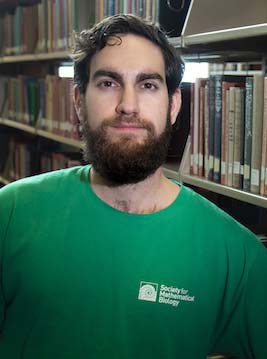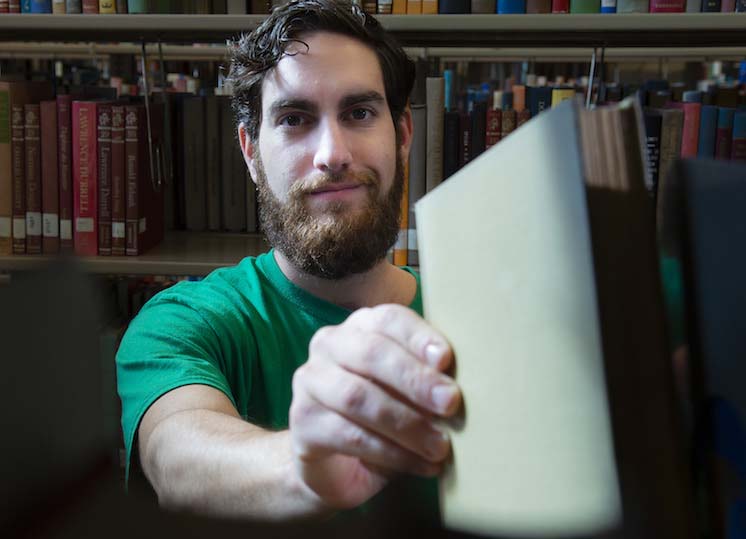

KENNESAW, Ga. | Jan 7, 2019
Math major searches for answers to African sleeping sickness

Sagi Shaier’s research on the spread of African trypanosomiasis, also known as “African sleeping sickness,” has brought the recent Kennesaw State University graduate international recognition. Shaier, a pre-med student who majored in computational applied mathematics with a minor in statistics, graduated summa cum laude last month.
Along with his faculty mentor, mathematics professor Meghan Burke, Shaier conducted epidemiological research on the spread of the disease by wild and domestic animals. As one of 10 Birla Carbon Scholars this year, Shaier was able to focus over the summer on his core research interests: mathematics, biology and medicine.
The pair’s research challenged the assumption that because domestic animals can be hosts for disease-spreading parasites, keeping domestic animals near human populations increases the spread of the disease.
They were invited to present their findings at the joint 2018 Annual Meeting of the Society for Mathematical Biology and the Japanese Society for Mathematical Biology, in Sydney, Australia. Out of more than 100 poster presentations, where 95 percent of the students were graduate students, Shaier’s work was rewarded with a third-place prize.
The Human African Trypanosomiasis parasite, which causes African sleeping sickness, is transmitted by the tsetse fly as a vector.
“It has several possible hosts, including wild and domestic animals, which are not as negatively impacted by the disease as the human host,” Shaier said. “However, several parameters found in the literature, including the shorter lifespan of the male tsetse fly vector, and the female vector’s preference for domestic animals, made us think that the animals’ presence could reduce the impact on the humans, instead of making it worse.”
The researchers developed a differential equation model to examine whether increasing the domestic animal population can be used to deflect the infection to humans and reduce its impact.
“Our equations were built to mimic a real village in Africa in which there are people who live and work, domestic animals and tsetse flies,” Shaier said. “Since every equation affects another – the flies affect the humans, but the humans also affect the flies – our model is a complex 9-dimensional matrix.”
Using special software, the pair were able to easily change the parameters in each model and immediately see the effects on the affected biological system over a 20-year period.
“Our analyses allowed us to propose novel methods of controlling the impact of the disease on humans,” said Shaier, who plans to become a physician.
They hope their work could lead to new ways of controlling the impact of the disease on humans.

Although Shaier was taking eight classes last semester – for a total of 23 credits – and spending tens of hours each week on his studies and research activities, he still could be found most Sunday afternoons tutoring STEM students in the Science Laboratory Building atrium.
Glen Meades, lecturer of chemistry and biochemistry, who has taught Shaier, said that’s not unusual.
“Students are there to help each other learn, and Sagi is there almost every Sunday,” Meades said. “Sagi is a very driven individual who has become a good friend to many students in the STEM community.”
Meades described Shaier as a very intelligent person who sets high standards for himself.
“Sagi is a stickler for going to class,” Meades said. “He is always there and he gets very disappointed in himself when he doesn’t meet his standards. He expects perfection from himself 100 percent, all of the time. He is not satisfied with less than perfection.”
While most of his drive and determination comes naturally, a three-year stint in the Israeli Defense Forces allowed Shaier to learn new subjects, including a new language. Shaier, who grew up speaking Hebrew, studied Russian in the military. The 26-year-old also speaks English and Spanish.
“I can speak English and Hebrew fluently,” said Shaier who grew up in Givatayim, a small town near Tel Aviv. “I have forgotten a lot of my Russian and Spanish as I haven’t practiced them in years, but I’m planning to review them in the next few months now that I have graduated. I also just completed a semester of Latin.”
When he’s not hitting the books or solving difficult equations, Shaier likes to venture outdoors.
“I love hiking. During the summer of ’15, I completed my hike on the Appalachian Trail, a 2,200-mile trek that goes from Georgia to Maine,” he said. “Other than the Appalachians, I have tried to explore as many mountains and different landscapes as possible from Australia to California to Germany.”
– Robert S. Godlewski
Photos by David Caselli
A leader in innovative teaching and learning, Kennesaw State University offers undergraduate, graduate, and doctoral degrees to its more than 51,000 students. Kennesaw State is a member of the University System of Georgia with 11 academic colleges. The university's vibrant campus culture, diverse population, strong global ties, and entrepreneurial spirit draw students from throughout the country and the world. Kennesaw State is a Carnegie-designated doctoral research institution (R2), placing it among an elite group of only 8 percent of U.S. colleges and universities with an R1 or R2 status. For more information, visit kennesaw.edu.